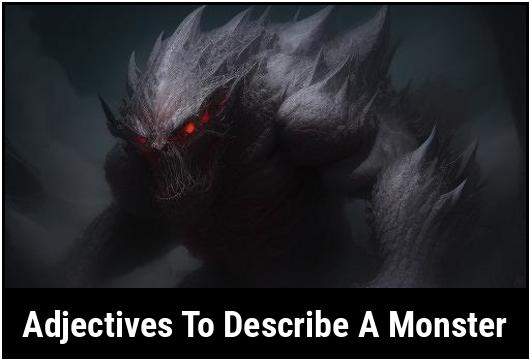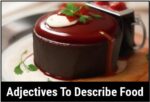- You are here:
- Home »
- adjectives
- » 31 Adjectives To Describe A Monster

31 Adjectives To Describe A Monster
When we think of monsters, we often conjure up images of terrifying, otherworldly beings that inspire fear and awe. Describing a monster with the right adjectives can not only enhance the storytelling experience but also provide vivid and evocative imagery for readers or listeners. The use of adjectives in describing a monster can create a palpable sense of dread, titillation, or curiosity. This article delves into the art of using adjectives to describe monsters and provides insights into selecting the most fitting adjectives to capture the essence of these fantastical creatures.
Key Takeaways
- Adjectives play a crucial role in capturing the essence of a monster’s appearance, behavior, and overall impact.
- The choice of adjectives can evoke specific emotions and reactions in the audience, enhancing the storytelling experience.
- Different types of adjectives, such as descriptive, emotive, and evaluative, can be used to convey various aspects of a monster’s nature.
Adjectives To Describe A Monster
1. Enormous
Monsters are often depicted as enormous beings, towering over anything in their path. Whether it be a colossal dragon or a towering giant, their sheer size commands attention and instills a deep sense of fear within us.
2. Sinister
These otherworldly creatures possess an air of sinister malevolence. With their ominous presence and wicked intentions, monsters strike fear into the hearts of even the most valiant warriors.
3. Monstrous
As the name suggests, monsters are truly monstrous. They possess an appearance that defies logic and stretches the boundaries of our imagination. From fangs to claws, their grotesque physical traits leave an unmistakable impact on all who encounter them.
4. Fierce
Monsters are fierce beings, often shown with an untamed and ferocious nature. With eyes burning with intensity and muscles rippling with power, these formidable creatures embody a primal sense of strength, ready to defend their territory at any cost.
5. Terrifying
One cannot discuss monsters without mentioning their terrifying nature. From the depths of the forest to the darkest corners of our minds, they tap into our deepest fears, sending shivers down our spines and causing our hearts to race.
6. Elusive
Monsters are known to be elusive, lurking within the shadows and remaining hidden from view. Their ability to vanish without a trace adds an air of mystery and unpredictability, leaving us in constant fear of their next move.
7. Devastating
When monsters unleash their might, devastation is inevitable. They can decimate entire villages and landscapes with a single swipe of their fearsome appendages. The aftermath of their wrath serves as a chilling reminder of their power.
8. Majestic
Despite their terrifying nature, monsters possess a certain majesty that captivates us. Whether it be the graceful flight of a mythical creature or the regal posture of a legendary beast, their presence exudes an unearthly beauty that is hard to ignore.
9. Supernatural
Monsters are often seen as supernatural beings, defying the laws of nature we are accustomed to. They possess abilities and attributes that transcend human comprehension, reminding us of the limitless possibilities that exist beyond our understanding.
10. Venomous
Some monsters possess venomous fangs or claws that inject potent toxins into their prey. This deadly attribute adds another layer of danger to their already awe-inspiring arsenal, leaving their enemies paralyzed with fear.
11. Intelligent
Contrary to popular belief, monsters aren’t always mindless beasts. Many possess a cunning intellect that allows them to outsmart their opponents, making them formidable adversaries. Their strategic prowess adds an element of intrigue to their already fearsome reputation.
12. Regenerating
Certain monsters have the ability to regenerate their wounds, making them nearly invincible. This supernatural ability ensures that they constantly pose a threat, regardless of any injuries inflicted upon them, making their persistence all the more terrifying.
13. Ghastly
Monsters often possess a ghastly appearance, causing those who lay eyes upon them to recoil in revulsion. With rotting flesh, skeletal features, or grotesque deformities, these creatures embody the macabre and haunt our nightmares.
14. Formidable
Monsters are unquestionably formidable opponents. With their immense strength, sharp claws, and swift movements, they strike fear into the hearts of warriors and bring even the bravest to their knees.
15. Inscrutable
The motives of monsters are often inscrutable, making them all the more terrifying. Their actions are often shrouded in mystery, leaving us to question their intentions and wonder what dark desires drive them.
16. Roaring
The thunderous roar of a monster can send chills down your spine. Their primal, earth-shattering bellow echoes through the air, signaling their presence and striking fear into anyone within earshot.
17. Haunting
Monsters possess the ability to haunt our dreams and infiltrate our thoughts. Their distinctive features etch themselves into our minds, and long after the encounter, their haunting presence lingers, leaving an indelible mark.
18. Stealthy
Many monsters possess a stealthy demeanor, moving without a sound through the darkness. Their silent approach instills a sense of dread, as they become masters of ambushes and surprise attacks.
19. Mystical
Certain monsters are steeped in mysticism, with origins drawing power from ancient legends and folklore. Their enigmatic nature conjures a sense of wonder and taps into the deep recesses of our imaginations.
20. Nightmarish
Monsters are the embodiment of our worst nightmares. With their grotesque appearance and vicious tendencies, they bring our darkest fears to life, making us question our own sanity.
21. Vicious
Monsters are known for their viciousness, attacking with unrelenting aggression. They show no mercy and tear through their adversaries with an unquenchable thirst for blood, creating an atmosphere of terror.
22. Imposing
Their stature alone makes monsters imposing creatures. Towering over their opponents, they command attention and respect simply through their physical presence, leaving those in their path trembling with fear.
23. Unforgettable
Encountering a monster is an experience that is forever etched into one’s memory. The sheer intensity of the encounter, coupled with the shock and terror they inspire, ensures that their image remains unforgettable.
24. Lethal
Monsters possess an inherent deadliness, honed through years of merciless predation. Their claws, teeth, or other weapons are capable of delivering fatal blows, making them a force to be reckoned with.
25. Mysterious
Monsters are shrouded in mystery, leaving us with more questions than answers. Their origins, intentions, and abilities often remain hidden, adding to their allure, and capturing our imaginations.
26. Otherworldly
Their existence seems to defy the natural order of the world. Monsters are often seen as beings from another realm, bringing an otherworldly presence that transcends our understanding and challenges our perception of reality.
27. Chilling
The mere thought of monsters sends a chill down our spines. From the cold sweat that forms on our skin to the hairs that stand on end, the presence of these formidable creatures can cause an icy shiver to run down our backs.
28. Demonic
In folklore and mythology, monsters are often associated with demonic entities. Their sinister aura and diabolical features evoke a sense of dread and unease, hinting at a dark force that resides within them.
29. Destructive
When faced with a monster, destruction and chaos follow in its wake. From crumbling cities to ruined landscapes, their actions leave a path of devastation that serves as a stark reminder of their power.
30. Relentless
Monsters are relentless in their pursuit, stopping at nothing to achieve their goals. Whether it be vengeance, hunger, or simply the instinct to survive, their unwavering determination ensures that they remain a constant threat.
31. Legendary
Legends and folklore are often rich with tales of awe-inspiring monsters. These creatures have transcended time and culture, forever etching their names into the annals of mythology. Their legendary status solidifies their place in our collective consciousness.
Why Use Adjectives To Describe A Monster
Monsters are inherently fascinating and often incite a sense of wonder, fear, or fascination. When describing a monster, whether in a literary work, a film, or a verbal narrative, the use of adjectives can shape the audience’s perception of the creature. By carefully selecting adjectives, a writer or storyteller can create a multi-dimensional portrait of the monster, conveying its physical features, demeanor, and impact on the world around it. Adjectives provide the opportunity to imbue the monster with nuanced characteristics, making it more compelling and memorable to the audience.
How To Choose The Right Adjective To Describe A Monster
Selecting the appropriate adjectives when describing a monster is a critical undertaking. It involves considering the specific traits, behaviors, and effects of the monster, as well as the intended emotional response from the audience. When choosing adjectives, it is essential to assess the overall portrayal of the monster and the narrative context in which it appears. This ensures that the adjectives not only embellish the monster but also contribute to the broader thematic and emotional resonance of the storytelling.
Types Of Adjectives For Describing A Monster
Descriptive Adjectives
Descriptive adjectives offer detailed information about the physical attributes and characteristics of the monster. These adjectives paint a vivid picture of the monster’s appearance, covering aspects such as size, shape, texture, color, and any distinguishing features. For example, a monster might be described as "gigantic," "slimy," "hulking," "spiky," or "iridescent," each of which provides a distinct visual impression.
Emotive Adjectives
Emotive adjectives convey the emotional impact or response elicited by the monster. These adjectives evoke feelings of fear, awe, revulsion, or fascination in the audience, capturing the visceral reaction to encountering the monster. Examples of emotive adjectives include "terrifying," "mesmerizing," "repulsive," "mysterious," and "intimidating," all of which contribute to shaping the audience’s emotional engagement with the monster.
Evaluative Adjectives
Evaluative adjectives assess the qualities or attributes of the monster in a judgmental or critical manner. These adjectives offer insights into the perceived nature of the monster, casting it in a particular light based on its behavior, abilities, or impact. For instance, a monster might be described as "ferocious," "cunning," "destructive," "elusive," or "unstoppable," reflecting the evaluative perspective of its traits and actions.
The art of using adjectives to describe a monster is a powerful tool for crafting compelling narratives and evocative imagery. Whether through descriptive, emotive, or evaluative adjectives, storytellers can imbue monsters with vivid detail, emotional resonance, and thematic significance. By carefully choosing adjectives that align with the intended portrayal and impact of the monster, writers and storytellers can captivate audiences and bring these fantastical creatures to life in all their terrifying, wondrous, or enigmatic glory.
Examples Of Adjectives For Different Types Of Monsters
In the realms of literature, folklore, and popular culture, monsters have always been a captivating subject. These mythical creatures range from fantastical beasts like dragons and werewolves to terrifying entities such as ghosts and vampires. When it comes to describing monsters, adjectives play a crucial role in capturing their essence, evoking emotions, and creating vivid mental images in the reader’s mind.
Using adjectives effectively can transport readers into the world of monsters, making the narrative more engaging and captivating. However, it’s important to choose the right adjectives to describe a monster accurately.
1. Ferocious Monsters
Ferocious monsters are known for their extreme aggression and savagery. They are often depicted as fearsome and eager to cause harm. Here are some adjectives that can be used to describe these types of monsters:
- Fierce: These monsters possess an intense and intimidating nature, often accompanied by powerful physical attributes.
- Vicious: This adjective signifies extreme cruelty and shows that the monster is inclined to cause harm without hesitation.
- Ruthless: A ruthless monster is merciless and lacking in compassion, making it a formidable foe.
- Savage: This adjective implies wildness and brutality, typically associated with creatures that exhibit untamed aggression.
- Bloodthirsty: This adjective emphasizes the monster’s unquenchable thirst for blood, symbolizing its insatiable desire for violence and destruction.
- Terrifying: This term indicates that the monster instills fear and anxiety in those who encounter it, often due to its physical appearance or menacing presence.
- Malevolent: A malevolent monster possesses a deep-seated desire to harm, fuelled by evil intentions.
2. Enigmatic Monsters
Enigmatic monsters are mysterious and often defy explanation or comprehension. They leave an air of uncertainty, and their intentions or nature may remain hidden. Here are some adjectives to describe these enigmatic creatures:
- Cryptic: This adjective describes a monster that is puzzling, secretive, and difficult to understand.
- Elusive: An elusive monster is challenging to catch or define, as it manages to remain just out of reach.
- Mysterious: A mysterious monster is one that triggers curiosity and uncertainty due to its hidden motives or nature.
- Enigmatic: Similar to mysterious, an enigmatic monster is puzzling and mysterious, leaving those who encounter it with more questions than answers.
- Uncanny: The uncanny monster is strange and unsettling, often giving off an eerie or unnatural vibe.
- Shrouded: This adjective implies that the monster is concealed or hidden beneath a layer of secrecy or mystery.
3. Supernatural Monsters
Supernatural monsters possess extraordinary powers or abilities beyond the realms of natural explanations. Here are some adjectives that can be used to describe these otherworldly creatures:
- Omnipotent: An omnipotent monster possesses unlimited power and authority, making it seemingly invincible.
- Ethereal: This adjective is used to describe a delicate, otherworldly monster that seems to belong to a different plane of existence.
- Transcendent: A transcendent monster surpasses the boundaries of normal existence, exhibiting qualities that elevate it above the mundane.
- Immortal: An immortal monster is impervious to death and the passage of time, lending it an air of eternal power and invincibility.
- Majestic: This term describes a monster that exudes a sense of grandeur and awe-inspiring magnificence.
- Spectral: A spectral monster is ghost-like in essence, existing in a state that is neither fully corporeal nor ethereal.
4. Monstrous Physique
Some monsters are known for their grotesque or terrifying physical forms. Here are some adjectives that can be used to describe their monstrous appearances:
- Hideous: This adjective emphasizes the repulsiveness or ugliness of the monster’s physical form, often provoking a strong sense of disgust or fear.
- Monstrous: This term describes a creature that is unnatural, deformed, or abnormally large, often causing horror or revulsion.
- Grotesque: A grotesque monster possesses bizarre or distorted physical characteristics that deviate from the norm, provoking a mix of fascination and unease.
- Looming: This adjective suggests that the monster appears to be approaching in a threatening and intimidating manner, creating a feeling of impending danger.
- Gargantuan: A gargantuan monster is enormous in size, inspiring awe and dread due to its sheer scale and magnitude.
- Serpentine: This term describes a sinuous, snake-like monster, often associated with cunning and treachery.
- Hulking: A hulking monster is massive in size and possesses a powerful, intimidating presence.
Common Mistakes In Using Adjectives To Describe Monsters
While adjectives can enhance the description of monsters, it’s important to use them correctly to avoid common mistakes. Here are some common errors to watch out for:
1. Overusing Generic Adjectives
Using generic adjectives like "scary," "big," or "evil" can make the description of monsters feel clichéd and uninteresting. While these adjectives have their place, it is essential to vary the language and employ descriptive adjectives that are more specific and evocative. This will make the description more vivid and engaging.
2. Inappropriate Adjectives
It is crucial to choose adjectives that accurately reflect the specific monster being described. Using adjectives that contradict the nature or appearance of the monster can confuse readers and break the immersive experience. For instance, describing a malicious monster as "gentle" would negate the very essence of its character.
3. Failing To Consider The Context
Adjectives should be selected with careful consideration of the context in which the monster is being described. A monster that is portrayed as powerful and intimidating in one situation may require different adjectives when depicted in a vulnerable state. Adapting the choice of adjectives to match the evolving circumstances can add depth and complexity to the description.
4. Ignoring Sensory Descriptions
When describing monsters, it’s important to engage multiple senses by incorporating adjectives that evoke a sensory experience. By describing the texture, smell, sound, or taste associated with the monster, the description becomes more immersive and memorable. Neglecting sensory descriptions can lead to a lackluster portrayal of the monster.
Using Adjectives Effectively
To create a more compelling description of monsters, here are some tips on using adjectives effectively:
1. Be Specific And Precise
Rather than using broad and generic adjectives, opt for more specific and precise terms that capture the unique qualities of the monster. Consider the monster’s behavior, physical attributes, and the emotions it evokes. Adjectives like "serrated," "lurking," or "dread-inducing" provide a more detailed and nuanced description than generic ones.
2. Use Comparative And Superlative Forms
Comparative and superlative forms of adjectives can be employed to highlight the extent or degree of certain qualities or characteristics possessed by the monster. For example, instead of describing a monster as simply "scary," one can opt for "horrifying" to intensify the fear it inspires. Similarly, using the superlative form, such as "the most monstrous," adds emphasis and enhances impact.
3. Employ Figurative Language
Similes, metaphors, and other figurative language devices can enrich the description of monsters, making it more evocative and imaginative. A metaphor like "his eyes were fiery orbs of rage" paints a vivid image of a furious monster, while a simile like "her scales glistened like obsidian" creates a striking visual depiction. Figurative language allows readers to connect with the description on a deeper level.
4. Consider The Monster’s Impact On The Environment
When describing monsters, it is crucial to consider their impact on the environment or surrounding atmosphere. Adjectives that evoke a sense of chaos, destruction, or any change in the surroundings can heighten the description. Describing how the ground trembles or the air becomes suffocating can elicit a visceral response in readers and enhance their immersion.
5. Pay Attention To Word Order And Sentence Structure
The placement of adjectives within a sentence can significantly impact the overall description. Placing adjectives before the noun they modify ("the terrifying, bloodthirsty monster") creates a different effect than placing them after ("the monster, terrifying and bloodthirsty"). Experimenting with word order and sentence structure can alter the emphasis and rhythm of the description, making it more dynamic.
Exercises And Practice
To reinforce the understanding and application of adjectives in describing monsters, here are some exercises and practice scenarios:
Exercise 1
Choose a monster from literature, folklore, or mythology and create a descriptive paragraph using adjectives to portray its appearance, behavior, and impact on the environment. Focus on employing specific and precise adjectives, as well as sensory descriptions.
Exercise 2
Read a description of a monster from a book or story and rewrite it using more evocative adjectives, comparative forms, and figurative language. Consider how the changes in adjectives enhance the impact of the description and create a stronger emotional response.
Practice Scenario
Imagine a fantastical world where a young protagonist encounters a fearsome dragon. Write a dialogue scene between the protagonist and a mentor figure, where they discuss the attributes and characteristics of the dragon. Incorporate descriptive adjectives into their conversation, highlighting the emotional and physical aspects of the creature.
Conclusion
Adjectives are powerful tools when it comes to describing monsters. By carefully selecting and employing descriptive adjectives, writers can create vivid depictions that captivate readers and evoke strong emotions. It is crucial to choose adjectives that accurately reflect the nature, appearance, and impact of the monster, while avoiding common mistakes such as overusing generic adjectives or neglecting sensory descriptions. By following the tips and exercises outlined in this article, writers can effectively enhance their descriptions and transport readers into the mesmerizing world of monsters.
FAQS On Adjectives To Describe A Monster
What Are Some Adjectives To Describe A Monster’s Appearance?
Some adjectives that could be used to describe a monster’s appearance are grotesque, hideous, monstrous, intimidating, and ferocious.
How Would You Describe A Monster’s Behavior?
A monster’s behavior can be described using adjectives such as aggressive, unpredictable, malevolent, savage, and cunning.
What Are Some Words To Describe A Monster’s Size?
When describing a monster’s size, words like colossal, enormous, gigantic, massive, and towering can be used.
Can You Give Some Examples Of Adjectives To Describe A Monster’s Strength?
Sure, some adjectives that could be used to describe a monster’s strength include formidable, powerful, rugged, sturdy, and robust.
How Could You Describe A Monster’s Personality Traits?
A monster’s personality traits can be described using adjectives like ruthless, cunning, manipulative, tyrannical, and relentless.








